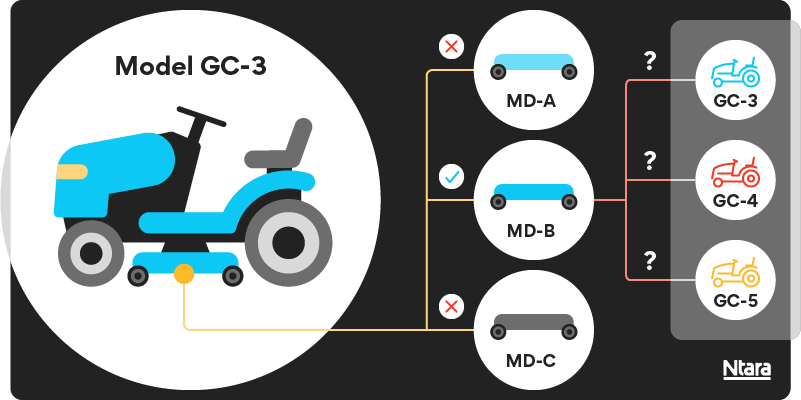Have you ever visited a retailer’s site to shop for a replacement part and been unable to find what you needed? Have you purchased parts you were unsure of because the site didn’t explicitly state the associated product models?
This lack of information is frustrating to consumers. They need confidence that what they buy will meet their need. Yet manufacturers often fail to properly document the relationships between their parts and pieces—and that causes big problems.
Say you’re selling a tractor on your site and it’s compatible with mowing decks A, B, and C.
A consumer typically takes one of two routes to find that information.
- They visit the tractor product page and browse its related parts
- They search for the part, then look for validation that it fits their tractor model
In the first option, the product page shows mowing decks A, B, and C as related parts. But if they go the second route and look up mowing deck A, does it relate back to the tractor model?

Every industry has product relationships, such as accessories, replacement parts, upgrades, and maintenance kits. With the right product information management (PIM) software, you can connect the data for these products and include additional descriptive information about how they work together.
As the complexity of these product relationships grows, PIM allows you to scale your relationship data. Correct product relationship data across all channels is critical for selling, cross-selling, and upselling.
Say your tractor customer is shopping for replacement mower blades. That’s fairly simple. But if they need to differentiate between an individual center blade, an individual outer blade, and a standard set of three blades, that’s a more complex set of relationship data.
Use case complexity grows exponentially when you consider your downstream channels. This isn’t just about your own ecommerce website. Your tractor customer could just as easily shop for replacement parts on Amazon or with their local distributor.
Like it or not, your part data in both cases is an extension of your company. If they buy a part that is supposed to fit your tractor and it does not, that’s a negative experience. They may lose trust in your parts—or your overall brand.
The manufacturer is responsible for ensuring accurate product data across all channels. For this reason, many retailers and marketplaces require product information to be sent directly from the manufacturer, indicating which parts fit which specific goods. Without PIM, it can be extremely challenging to get it right.
Establishing processes for product relationships
First, your business must have a clear understanding of your product relationships. This data should be captured early in the process—ideally during product data modeling. Doing this creates the infrastructure you need to document all current and future product relationships.
This is particularly true for customizable products that need configuration to work.
To ensure an accurate and cohesive understanding of these relationships, consider how customers seek information. Consider how your downstream channels expect to receive and display that information. To manage all this and more, you need a standardized system for capturing and syndicating product data.
To get started, assess your existing data for each piece and part. Do you have a clear understanding of the relationships? If not, focus here first.
From there, select a PIM software that meets your needs. It must be intuitive for team members who are not highly technical. Many companies assume that their IT team will be heavily involved in PIM when, in fact, it’s usually the product and marketing teams.
Your PIM software should make capturing, enriching, and syndicating data easier for these teams. Software such as inriver Syndicate can automate product content distribution to channel partners, retailers, and marketplaces with a simple, easy-to-use interface.
When you streamline your data collection and distribution, you can more easily track every detail needed to create an effective buying experience. With consistent relationship data between parts and products, your customers can feel confident that they’re buying the right product and’ll be more confident in you as a company.
If you’re ready to reassess your product relationship data and aren’t sure where to start, let us know.